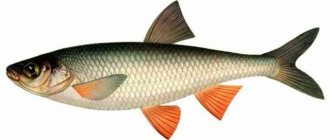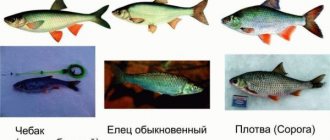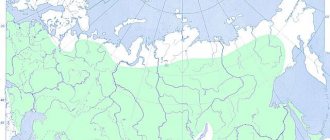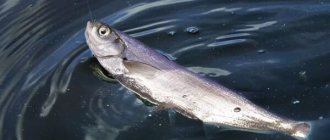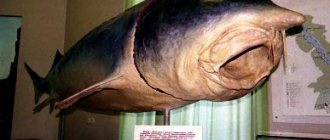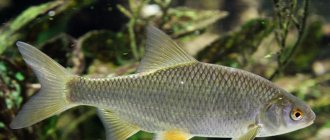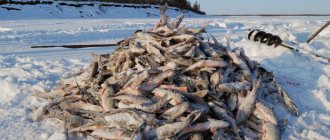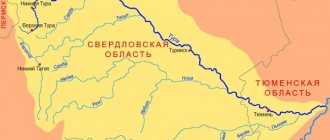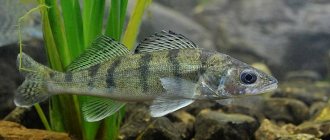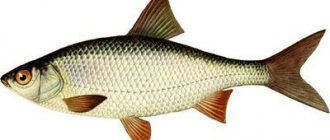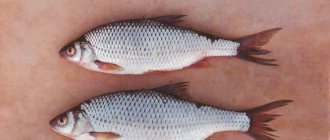Chebak - what kind of fish is it?
The answer to the question of what kind of fish a chebak is and what it looks like is quite simple if you find out its second name - “Siberian roach”. This is a representative of cyprinids, which lives in artificial and natural water bodies of the Urals and Siberia, not counting mountain rivers with very fast flows.
Chebak has a lot in common with roach: the silver color, sparkling in the sun, above the lateral line begins to smoothly turn into a gray-green-blue color with a tint, and the weight of the flattened body with a pointed head does not exceed 700 g. Since the subspecies is very prolific, it is caught in industrial scale. The fish's diet mainly consists of algae, mollusks and insect larvae.
Fried fish in a frying pan
The recipe for cooking chebak fish in a frying pan is very simple and requires a minimum of ingredients. The main difficulty is only cleaning the catch from scales. Although when buying at the market, you can ask that the fish be cleaned on the spot.
Ingredients for preparing fried Siberian roach:
- 2 kg of fish;
- 300 g flour;
- 2 onions;
- 70 ml sunflower oil;
- ground pepper and salt.
Cooking method:
- Cleaned and gutted fish are well dried with a cloth.
- The chebak is salted, rolled in flour and placed in hot oil.
- When the browned side is on top, the chebak is crushed with chopped onion.
- Then the roach is turned over again and sprinkled with pepper.
Salting chebak fish
To salt chebak fish you will need:
- 2 kg of fish;
- 200-300 g of salt, depending on taste preferences;
- spicy spices.
The work progress consists of performing the following manipulations:
- Fresh or defrosted fish at room temperature is washed.
- A clean container for salting is prepared, along the bottom of which salt is distributed as a cushion.
- Next, the first layer of fish is laid, sprinkled with salt crystals and a small amount of spices.
- All Siberian roach are laid out in this way.
- The last layer is also sprinkled with salt, after which the container is placed in a cool place for 2 days.
- After the specified time, the chebak is soaked for an hour or two so that the dried fish does not turn out to be too salty.
- The chebak is dried wrapped in gauze in a well-ventilated area. The process takes 2 days.
Oven baking recipe
Chebak baked in the oven is low in calories and is ideal for dietary nutrition.
To prepare a delicious dinner for the whole family, you will need:
- 1 kg roach;
- 8 potato tubers;
- 400 ml sour cream;
- 200 g cheese;
- bulb;
- ½ lemon;
- salt and pepper.
Sequence of actions:
- The chebak is cleaned, gutted, and freed from heads, fins and large bones.
- The fillets are cut into pieces 5 cm wide.
- Juice is squeezed out of ½ lemon.
- Fish pieces are salted, seasoned, sprinkled with lemon juice and refrigerated for 30 minutes.
- The vegetables are peeled, after which the potatoes are cut into slices and the onion into half rings.
- The cheese is grated.
- The prepared ingredients are laid out in layers in a greased form: potatoes, fish and onions.
- Vegetables are pre-salted.
- The top layer is covered with sour cream, after which the mold is sent to the oven, preheated to 170℃ for 50 minutes.
- 10 minutes before the end of baking, crush the dish with cheese shavings.
How to cook chebak?
The fish is cooked in the oven on a baking sheet, which is pre-lined with parchment. The carcasses are already placed on top. Now all you have to do is preheat the oven to 150 degrees and place the chebak in there for half an hour. According to experts, this is how much fish is cooked in ovens with bottom and top heating. If you have a cabinet with only bottom heating, then most likely you will have to extend the procedure by 10-15 minutes. To prevent your food from burning, place the baking sheet in the center of the cabinet. The finished chebak should have a light golden hue.
Description of chebak fish
Appearance
This fish has a tall body with large scales, a short head, and a high fin on the back with nine or ten branched rays.
As a rule, the back of the chebak is light in color - bluish or greenish. The sides of the Siberian roach are silvery, and the fins are bright orange or red. The eyes are orange in color.
This fish, despite its rapid growth, as a rule, does not grow large, reaching an average length of about thirty to forty centimeters. The weight of chebak usually does not exceed several hundred grams, maximum – 700-800 grams.
Habitat
Chebak, like other freshwater roach, is found:
- in small rivers
- in ponds,
- in big rivers
- large lakes,
- in reservoirs.
Almost everywhere, the chebak occupies one of the leading places among other fish species in terms of numbers.
In Russia, the chebak lives in the reservoirs of the Urals and Siberia. So, it is actively found in the following rivers:
How to catch more fish?
Over 13 years of active fishing, I have found many ways to improve the bite. And here are the most effective:
- Bite activator. Attracts fish to cold, warm water with the help of pheromones included in the composition and stimulates its appetite. It’s a pity that Rosprirodnadzor wants to ban its sale.
- More sensitive tackle. Read the relevant guides for a specific type of tackle on the pages of my website.
- Pheromone-based lures.
You can get the rest of the secrets of successful fishing for free by reading my other materials on the site.
- Tobol,
- Irtysh,
- Indigirk,
- Kolyma,
- Khilok,
- Chikoy.
Siberian roach can also be found in freshwater lakes of the Urals, Siberia and the Far East.
Spawning
The Siberian roach reaches sexual maturity at three to five years of age, when its length is ten to twelve centimeters.
The breeding season occurs in May, when the water temperature is not lower than 8-10 degrees. Individuals of Siberian roach gather in schools, after which spawning begins. It usually occurs at a depth of two to five meters, but in the event of a strong and unexpected cold snap caused by strong winds, spawning can occur at a depth of ten meters.
Chebak is a very prolific fish. The female can lay several tens of hundreds of eggs at a time.
After spawning, schools of fish go to a depth of twenty to thirty meters, where there is algae, and actively eat shellfish. After a couple of weeks, fry emerge from the eggs.
Diet
Siberian roach eats:
- seaweed,
- larvae of various insects,
- small crustaceans,
- worms
Fishing
The fishery for Siberian roach is very developed. Despite the fact that in terms of taste it is in some ways inferior to the vobla from the Volga, however, certain types of chebak can be quite large and fatty.
Popular cooking methods and recipes
There are many folk methods for preparing chebak. If you follow the advice of experienced chefs, you will be able to preserve the best properties and taste of the fish.
Frying chebak fish
We remove the scales from the fish, remove the entrails, and take out the gills. Grease with salt and pepper, coat with beaten egg and place in a heated frying pan. Fry the onions and add to the fish.
Baking in the oven
We immerse the peeled and gutted chebak in a marinating container. Cover completely with crushed garlic. Sprinkle with a little salt and stir. Add lemon juice and fish seasoning. Marinate for 30 minutes, then place on a baking sheet lined with foil. Wrap and place in a preheated oven. Bake for 30 minutes at 150 degrees.
Dried chebak
Fish cannot be gutted before drying. The scales also remain. We first freeze the carcasses for several days to kill germs. Place the fish in a deep container in layers and cover with salt. You can add red pepper to make the fish spicy. It is better to place larger fish at the very bottom.
Salt the fish for 2 hours, then put pressure on it and hold for another 2 hours. Then you need to wash off the salt and hang the fish by the tail for hanging on the balcony or in a well-ventilated place. If the back is hard, then the fish is completely dried.
Steamed dishes
You can use a slow cooker for cooking.
Ingredients:
- chebak;
- potato;
- celery;
- carrot;
- greenery;
- cauliflower;
- spices to taste.
Lubricate the fish with vegetable oil and sprinkle with spices. Cut the vegetables into small cubes, add to the chebak and add salt. Place finely chopped parsley on top.
Add water to the multicooker and place the container with the ingredients. Cook for 20 minutes.
Salting fish
We remove the scales, head and entrails from the carcasses and wash them under running water.
Brine ingredients:
- carnation;
- allspice peas;
- Apple vinegar;
- salt;
- Bay leaf.
Add spices to boiled water to taste and cook the brine, then cool. Place the fish carcasses in a pan and fill with brine. Pour apple cider vinegar on top and stir. Add a little vegetable oil. Press the fish with an inverted plate and place it in the refrigerator for 2 days.
Rich ear
To prepare fish soup, it is better to use small fish. We clean it, remove the entrails and gills. Cut the potatoes into large pieces and place them in a saucepan with salted water. Then chop the carrots and add them to the potatoes. Add a whole onion. Place the fish in the pan to the very top. Cook over low heat, periodically remove the foam, but do not stir so that the chebak does not fall apart. After 15 minutes, add bay leaf and ground pepper. Cook for another 5 minutes, then cover with a lid and turn off the gas. The fish soup should sit for 2 hours for the flavor to be rich. Carefully remove the boiled fish and onions from the pan.
Fishing for chebak
Nozzles
The following are suitable attachments for chebak when fishing with a float rod:
- worm,
- maggot,
- bloodworm,
- caddisfly
- bark beetle,
- lamprey larva,
- insects,
- pearl barley,
- dough,
- bread.
Experiment with attachments! Any of them can be suitable, at the same time, any chebak can be rejected. Therefore, when going fishing, it is best to have several bait options in stock, finding out the preferences of the Siberian roach in a particular body of water.
Issyk-Kul chebak
Separately, it is necessary to mention the fish, which is called the Issyk-Kul chebak. So, this fish is a distant relative of the roach, as it belongs to the genus dace and is a pelagic fish.
The habitat of this chebak is limited to Lake Issyk-Kul; it practically does not enter the rivers that feed it, although it tries to stay in coastal areas desalinated by them with depths of up to 15 meters. The Issyk-Kul chebak overwinters far from the shore, where the bottom drops 50-70 meters.
This fish reaches a weight of 500-600 grams with a body length of up to 35 centimeters. It begins to spawn in the fourth year of life in coastal thickets of grass or snags in late March - mid-April, depending on weather conditions.
Chebak soup
This first dish will be appreciated by those who love river fish.
- chebak – 600 g;
- potatoes - 4 pieces;
- millet – 30 g;
- onions – 1 piece;
- dill – 3 sprigs;
- bay leaf – 2 pieces;
- salt and pepper - to taste.
- Clean the fish, remove the entrails and place it in a pan of boiling water.
- Peel the potatoes and cut into large cubes. Cut the onion into large slices.
- After 15 minutes, remove the chebak with a slotted spoon and set aside for a while.
- Strain 2 liters of broth, bring it to a boil, and then add vegetables, herbs and bay leaves to it.
- After another 10 minutes, put the cereal in your ear.
- Cook the soup for another 10-15 minutes.
Delicious recipe! Cake dough with cottage cheese
Pour the fish soup into plates and place pieces of boiled fish in each.
Chebak contains only 100 kcal per 100 grams, so dishes made from this fish are suitable for dietary nutrition.
Chebak fish is an excellent source of easily digestible protein and other micronutrients such as iodine, phosphorus, and calcium. In Siberia, this fish is very popular and is often present in different forms on the tables of both avid fishermen and simply lovers of fish dishes.
Ichthyology
The Siberian chebak is slightly different from the ordinary roach in the following parameters:
- more elongated body;
- less red dorsal fin;
- The iris of the eye is not so red.
Otherwise, these subspecies are similar, and many agree that this is one species, which has changed slightly in appearance due to its habitat. Also, many people confuse the chebak with the roach, from which it differs in its taller body and less bright feathers.
Lifestyle and nutrition
The Siberian chebak lives in all types of reservoirs, both in rivers and in lakes and ponds. There his favorite places are similar to ordinary roaches:
- riverbed holes;
- bank and channel edges;
- any lowering of the bottom in shallow waters overgrown with vegetation;
- at pitfalls;
- rapids overgrown with algae;
- snag and other interesting places.
Like many other carp fish, chebak in the evening tends to rise from the depths to shallow water for caddisfly, which is a favorite delicacy for Siberian roach.
Taking advantage of this, many anglers have learned to successfully catch it in the dark.
For the winter, chebaks descend to depths, but do not stop feeding, which especially pleases all fishermen in the Trans-Ural region.
The chebak is unpretentious in nutrition; its diet contains a variety of plant and animal foods, for example:
- seaweed;
- higher aquatic plants;
- shellfish;
- bloodworms and caddisflies;
- insects;
- larvae;
- worms;
- crustaceans.
In the spring and during the post-spawning period, Siberian roach mainly feed on mollusks and worms; after spawning, the fish descend to great depths. In the second half of summer, chebaks gather in small flocks and rise to the shores to feed, at which time they consume abundantly both animal and plant food.
Such approaches to the shores of the chebak last from ten to fifteen days, then the schools again sink to the bottom. A second landfall may occur in late summer or early autumn.
It should be noted that this behavior of the chebak has long been noticed by people. These outlets are used for coastal commercial seine fishing for this fish.
Age and spawning
On average, the life expectancy of a roach is about ten years, and at the age of three, the Siberian roach begins to spawn. Her breeding process begins with a spawning run to places of future mating games and takes from two to three weeks.
When flocks of chebak rise to the spawning grounds, the water has time to warm up to 9 degrees Celsius; in different regions this moment occurs from mid-April to early May.
The Siberian roach chooses quiet shallow bays as a place for love games, often water meadows.
Young individuals begin spawning; after a day or two, middle-aged individuals begin spawning, and after another couple of days, the oldest chebaks begin. Mating games take place quite violently: with noise effects that can be heard at a far distance from the reservoir.
Attention opisthorchiasis! Be careful when eating chebak, it is one of the most contaminated and most epidemiologically important fish species in the Ob-Irtysh basin and some other territories.
Chebak fishing season
There are quite a lot of places where fish swim and live. At the same time, the Siberian roach prefers quiet waters, but they do not neglect currents. Basically, it is distributed throughout the entire reservoir, so you can catch it with a fishing rod anywhere, regardless of the depth of the reservoir or the bottom topography. Many fishermen who are actively involved in their activities say that the maximum number of individuals of this breed is found in shallow rivers and lakes, where growing algae are present.
In the evening, fish bite differently, so there are disagreements among fishermen on this matter. The fact is that on some evenings the chebak is quite active, and the catch is maximum. However, the next day, in the evening, such activity is no longer observed. Not only the fishing season, but also the weather has a special impact on the bite. If the evening is hot and sunny, the chebak will not continue to swim at night. At the same time, if the weather is cloudy, then the catch will be good.
Winter
The most successful period for winter fishing for chebak is the time from November to February. However, in January the number of fish caught is not so high. As soon as the first ice appears on the reservoir, this species begins to be very active. At the same time, from the moment the ice thickness increases, the fish loses interest and tries to go deeper.
The best time of day, when the maximum chebak bite is observed, is called early morning. You can also catch a lot of fish after lunch. As soon as the sun disappears, chebak fishing ends. If there are frequent weather changes, then it is better to refuse fishing on this day. The greatest number of fish is observed on cloudy days.
In winter, the chebak hides in concave coastal areas, as well as in deep reaches. This is where the fish spend the winter. As soon as the thaw sets in, individuals try to rise from the depths, entering shallow water.
When fishing takes place on ice, experts give preference to ordinary float rods that have an elastic nod. In addition, jigs without attachments, as well as with natural baits, are considered the most popular among fishermen.
Don't worry if the fish doesn't bite. It is important not to be lazy, but to constantly try. It is important to change your location, jig and nozzle.
In addition, do not forget about feeding when catching chebak. If you fish at shallow depths, then give preference to ground breadcrumbs and crushed seeds. If the depth is significant, then the best bait is a small feeder.
When fishing for Siberian roach in winter, the best solution is to use a variety of flavors, which are based on alcohol (the smells are varied, but meat, fish and spicy ones are best suited for winter fishing).
Spring
As soon as the ice melts from the reservoirs, fishermen appear on them. It is the fishing of chebak that will mark the beginning of the open water fishing season. At the same time, in the spring you can either leave with a good catch or fail. The fact is that the water in the reservoirs has not yet fully risen, and the fish have not gone to spawn. By the way, fishing at this time of year has significant differences. So, it is in the spring that the chebak forms large groups and also begins to look for food. In addition, females try to find a place for spawning. This is also worth considering if you decide to go spring fishing for Siberian roach.
In spring it is easier to catch fish using bait of animal origin. The fish “comes out of hibernation” and tries to replenish its strength before spawning. Fishermen prefer spring fishing also because the number of fish caught exceeds imaginable limits. Be sure to check the weather forecast before fishing for chebak. So, the maximum catch will be on days when a thunderstorm is expected to occur. It is at this time that the number of fish reaches a greater value.
Summer
In summer, the Siberian roach is not particularly active. True, fishermen note that you can catch it with a regular spoon, using even bread crumbs.
In the summer, it is worth catching chebak with a feed bloodworm. In addition, another type of bait that is popular with fish is sweet cookies, previously soaked in water.
If you are fishing in a body of water with a current, then preference should be given to fine-grained breadcrumbs, grain bran and other baits. Such components have a cloudy trail.
Small individuals bite throughout the day, while adult chebak fish are active only in the early morning and late evening.
Tackle
When fishing for chebak, you use almost the same fishing rods that are used for fishing for common roach, for example:
- float;
- bottom;
- onboard;
- winter.
In addition, catching large chebak with a spinning rod on a rotating spoon of zero or first size can be successful.
Float
ADVERTISING loading...
All types of float gear are also applicable to catching chebak. The use of a particular fishing rod depends on the distance and depth of fishing, as well as the preference of the angler.
- Fly and Bolognese rods are used when fishing from the shore at short and medium distances, as well as when fishing from a boat in a still body of water.
- The plug is used for an average fishing distance of up to 16 -20 meters. This tackle works well both in still water and on the river.
- A match rod with a cone-shaped spool on an inertia-free reel is used for catching Siberian roach at long distances.
Winter gear
Fishing for chebak in winter is carried out using three types of gear:
- float rod;
- jig with a nod;
- fishing rod for the current.
The winter float fishing rod differs from others in that it is tied to a feeding area; this method is used by bream fishermen on large lakes and reservoirs.
More popular fishing for chebak in winter is carried out with a fishing rod equipped with a nod and jigs. In this option, reelless fishing with baitless jigs and flies is also possible.
The fishing rod for the current is equipped with a bright guard, a feeder and feeder equipment, most often a helicopter or paternoster. Fishing for chebak in winter is carried out with such gear using a stationary feeder or a miniature one located directly in the gear.
Lures
Just like common roach, chebak can be caught using a wide variety of plant and animal baits, for example:
- maggot;
- caddisfly;
- worm;
- mormysh;
- bakery products;
- semolina or wheat dough;
- peas;
- corn;
- pearl barley;
- wheat grains;
- pasta;
- Hercules flakes.
Various combinations of baits also work. For example, one of the hits that the chebak readily bites on is the combination of corn - star - maggot. It is in this sequence that they need to be put on the hook.
Chebak fish: description
Appearance
This type of roach is distinguished by a high body, on which there are large scales. The head is quite short, and on the back there is a high fin with numerous rays.
Basically, the back of the chebak is painted in a bluish or greenish tint, and the sides are brightly silver in color. The fins are orange or bright red. The eyes are orange in color.
Despite its active growth, the chebak does not grow more than 40 centimeters in length, with a maximum weight of about 900 grams.
Where is this fish common?
Chebak, like any roach, prefers fresh water bodies, such as:
- Not big rivers.
- Ponds.
- Big rivers.
- Big lakes.
- Reservoirs.
In almost all bodies of water that the chebak inhabits, this fish is the most numerous. In Russia, the chebak is found in the reservoirs of the Urals and Siberia. It is found in large quantities in the following rivers:
- Tobol.
- Irtysh.
- Indigirka.
- Kolyma.
- Khilok.
- Chikoy.
This type of roach is also found in lakes of the Urals, Siberia and the Far East.
Spawning
The chebak begins to spawn when it reaches 3-5 years of age, when its length reaches 10 centimeters. The breeding process begins in May, when the water warms up to +8 degrees. During this period, the chebak gathers in small flocks and spawning begins. As a rule, Siberian roach lays eggs at a depth of 2 to 10 meters, depending on weather conditions. The colder it is outside, the deeper the fish lay their eggs.
Chebak is considered a prolific fish, since the female can lay tens of thousands of eggs at a time. After spawning, the fish goes to depth, where it regains its strength, actively feeding on algae and mollusks.
After about two weeks, fish fry emerge from the eggs.
What does a chebak eat?
The Siberian roach feeds on:
- Algae.
- Larvae of various insects.
- Small crustaceans.
- Worms.
Commercial fishing
Siberian roach is caught on an industrial scale. In terms of taste characteristics, the chebak is inferior to the roach, which is found in the Volga River, but certain types of chebak reach large sizes and gain significant weight. Of course, if we compare the subspecies of roach.
How to dry chebak fish
Dried Siberian roach is a delicacy for the summer season, which is eaten much faster than it is prepared.
To enjoy dried fish, you need:
- 1.5 kg of gutted chebak fish;
- 5 times less salt.
The preparation method consists of the following steps:
- The bellies of the fish are ripped open and the entrails are removed.
- The prepared chebak is washed well.
- Each fish is rubbed with salt inside and out.
- The prepared roach is placed in a container, which is covered with a lid and left for a day at room temperature.
- After the specified time has passed, the fish is turned over to the other side so that the salt is distributed evenly, and left for the same amount of time.
- Then the procedure is repeated again.
- When the salting process is completed, the brine is drained, and the fish is washed and filled with clean water.
- After half an hour, the water is changed to fresh.
- After 30 minutes, the chebak is laid out on a wire rack, where toothpicks are inserted into the bellies, and paper clips are threaded through the eye area.
- Siberian roach is hung in a well-ventilated area, covered with gauze and dried for a week.
Fishing for chebak
Gear selection
As a rule, chebak is caught with a regular float rod, although some anglers also use a spinning rod for this.
Catching chebak with a spinning rod
To do this, it is recommended to take a light spinning rod with minimal dough. The smallest size spinners and spoons are suitable as bait. As a rule, these are spinner sizes from 0 to 1, and it makes no sense to use larger spinners. Chebak is not a predatory fish, so catching it with live bait also makes no sense.
Nowadays, the most attractive baits may be made from edible rubber, which can imitate various insects.
Catching chebak with float tackle
To catch this fish, just arm yourself with a regular float rod and find a suitable place. As bait you can use:
- Worms.
- Maggot.
- Bloodworm.
- Caddis fly.
- Bark beetle larvae.
- Lamprey larvae.
- Various insects.
- Barley.
- Dough.
- Bread.
What does chebak fish look like?
Having learned what a chebak is, a logical question arises: what is the difference between a roach and a chebak. The main difference by which it is easy to distinguish a chebak is its high body, covered with large scales. The difference between the chebak and the roach is a short head with a high fin (consists of a large number of rays).
Mostly, there are individuals with green or blue backs and silvery sides. The fins are bright: either red or orange. The characteristic eye color is orange.
Chebak, from its family of fish, is one of the most useful and promising species for both private and industrial fishing. The fish grows actively, eating various insects, but does not grow to large sizes. It is extremely rare to catch fish longer than 40 cm, and the maximum weight is 900 g.
This fish is a subspecies of roach
Chebak fish recipe in the oven
Fish can also be cooked at home in the oven. We offer you the option of a hearty dinner for the whole family.
- chebak – 1 kg;
- medium-sized potatoes - 8 pieces;
- sour cream – 400 g;
- hard cheese – 200 g;
- onion – 1 piece;
- lemon – 0.5 pieces;
- salt and spices - to taste.
- Clean the fish, gut it, cut off the head, tail and fins. Remove the bones.
- Rinse the workpieces under running water, then cut them into pieces 5-6 cm wide.
- Mix the fish with salt, spices and lemon juice. Marinate the pieces for 20 minutes.
- Cut the peeled potatoes into rings 0.7 cm wide. Cut the onion into half rings.
- Grease a baking dish with a diameter of 30-35 cm with oil. Place potatoes, fish and onions in rows. Salt the vegetables.
- Spread the onion layer with sour cream.
- Place the mold in an oven preheated to 170 degrees for 40 minutes.
- When the required time has passed, sprinkle the dish with grated cheese and bake it for another 10 minutes.
Serve the dish hot.
Habitat
The places where chebak fish are found are no different from the roach’s favorite reservoirs. Chebak is more of a river fish, but it also feels good in reservoirs with weak or no current. The main condition for the presence of chebak is fresh water. In most reservoirs inhabited by chebak, this fish is the most numerous species.
You can catch a subspecies of roach in most reservoirs, rivers and lakes in Siberia, the Urals and the Far East. The largest number of fish is found in:
- Irtysh;
- Khiloke;
- Kolyma;
- Tobole.
About steaming
Due to the fact that during frying, chebak loses most of its beneficial substances, namely calcium, protein and iron, experts recommend steaming this fish. It is best to use a slow cooker for this purpose. If you follow the recipe, then in addition to 1 kg. For chebak you will need celery (3 branches), soy sauce (10 ml), garlic (2 cloves), olive oil, pepper and salt. Cleaned and gutted fish are removed from the ridge and large bones. You should end up with several fillet pieces.
You need to rub salt and ground pepper into them. Afterwards, the fish is placed in a container, the bottom of which is pre-lined with food foil. A sauce is prepared from ginger, garlic and celery, which will need to be poured over the chebak. In a slow cooker, this fish will be ready in half an hour.
Delicious recipe! Quick bread without yeast in a slow cooker
River fish chebak is widespread in the Urals and Siberia. It can be baked on the grill or in the oven, fried in a pan or boiled. Use our recipes and please your loved ones with new dishes.
- Number of servings: 8
- Preparation time: 20 minutes
- Cooking time: 20 minutes
Chebak spawning
In total, the chebak can live about 10 years. The Siberian roach reaches sexual maturity at the age of 3-5 years; now the length of the fish is about 10 cm. Spawning of the roach directly depends on weather conditions. It prefers to start breeding when the water temperature reaches 8°C, which is typical for the month of May. Now the fish gather in small schools and swim to their spawning grounds. Chebak often chooses deep places for spawning, usually at a depth of 2-10 m, so that the eggs do not freeze. There is a pattern: the lower the ambient temperature, the deeper the spawning ground is located.
The Siberian roach is quite strong; it chooses remote areas for spawning. Often, swimming to spawning grounds takes about 2-3 weeks. As the flock moves, the water warms up even more. Suitable places for spawning are quiet bays with shallow depths. Sometimes it lays eggs in flooded meadows.
Small individuals go first to spawn; after a day or two, medium-sized individuals become involved in the process. After a few more days, large chebaks begin to spawn. At the stage of selecting males, mating games take place. Large numbers of splashing fish can be easily heard over long distances.
The chebak is quite prolific; a medium-sized female lays about 50 thousand eggs. After spawning, the fish tends to go deeper into the water to recuperate. Now her appetite is awakening, she eats large quantities of shellfish and algae. The eggs hatch into fry within 2 weeks.
Spawning of chebak directly depends on weather conditions
Features of catching chebak
Fish are hunted all year round, but the best time is summer and spring. Catching chebak in winter is also possible. It is found at various depths in most bodies of water. The wide distribution of fish has led to an increase in the number of fishermen hunting for them.
Important! Particular care must be taken when consuming chebak, because this species is one of the most contaminated. When eating poorly cooked fish, opisthorchiasis infection may occur.
